Developers
Client SDKs
AMP
AMP SDK
Android
Initialization
Configuration
Network Security Configuration
Event Tracking
User Attributes
IDSync
Screen Events
Commerce Events
Location Tracking
Media
Kits
Application State and Session Management
Data Privacy Controls
Error Tracking
Opt Out
Push Notifications
WebView Integration
Logger
Preventing Blocked HTTP Traffic with CNAME
Workspace Switching
Linting Data Plans
Troubleshooting the Android SDK
API Reference
Upgrade to Version 5
Cordova
Cordova Plugin
Identity
Direct Url Routing
Direct URL Routing FAQ
Web
Android
iOS
iOS
Workspace Switching
Initialization
Configuration
Event Tracking
User Attributes
IDSync
Screen Tracking
Commerce Events
Location Tracking
Media
Kits
Application State and Session Management
Data Privacy Controls
Error Tracking
Opt Out
Push Notifications
Webview Integration
Upload Frequency
App Extensions
Preventing Blocked HTTP Traffic with CNAME
Linting Data Plans
Troubleshooting iOS SDK
Social Networks
iOS 14 Guide
iOS 15 FAQ
iOS 16 FAQ
iOS 17 FAQ
iOS 18 FAQ
API Reference
Upgrade to Version 7
React Native
Getting Started
Identity
Unity
Upload Frequency
Getting Started
Opt Out
Initialize the SDK
Event Tracking
Commerce Tracking
Error Tracking
Screen Tracking
Identity
Location Tracking
Session Management
Xamarin
Getting Started
Identity
Web
Initialization
Configuration
Content Security Policy
Event Tracking
User Attributes
IDSync
Page View Tracking
Commerce Events
Location Tracking
Media
Kits
Application State and Session Management
Data Privacy Controls
Error Tracking
Opt Out
Custom Logger
Persistence
Native Web Views
Self-Hosting
Multiple Instances
Web SDK via Google Tag Manager
Preventing Blocked HTTP Traffic with CNAME
Facebook Instant Articles
Troubleshooting the Web SDK
Browser Compatibility
Linting Data Plans
API Reference
Upgrade to Version 2 of the SDK
Alexa
API References
Data Subject Request API
Data Subject Request API Version 1 and 2
Data Subject Request API Version 3
Platform API
Key Management
Platform API Overview
Accounts
Apps
Audiences
Calculated Attributes
Data Points
Feeds
Field Transformations
Services
Users
Workspaces
Warehouse Sync API
Warehouse Sync API Overview
Warehouse Sync API Tutorial
Warehouse Sync API Reference
Data Mapping
Warehouse Sync SQL Reference
Warehouse Sync Troubleshooting Guide
ComposeID
Warehouse Sync API v2 Migration
Calculated Attributes Seeding API
Bulk Profile Deletion API Reference
Data Planning API
Group Identity API Reference
Custom Access Roles API
Pixel Service
Profile API
Audit Logs API
Events API
mParticle JSON Schema Reference
IDSync
Quickstart
Android
Overview
Step 1. Create an input
Step 2. Verify your input
Step 3. Set up your output
Step 4. Create a connection
Step 5. Verify your connection
Step 6. Track events
Step 7. Track user data
Step 8. Create a data plan
Step 9. Test your local app
iOS Quick Start
Overview
Step 1. Create an input
Step 2. Verify your input
Step 3. Set up your output
Step 4. Create a connection
Step 5. Verify your connection
Step 6. Track events
Step 7. Track user data
Step 8. Create a data plan
Python Quick Start
Step 1. Create an input
Step 2. Create an output
Step 3. Verify output
Server SDKs
Node SDK
Go SDK
Python SDK
Ruby SDK
Java SDK
Guides
Partners
Introduction
Outbound Integrations
Outbound Integrations
Firehose Java SDK
Inbound Integrations
Compose ID
Glossary
Migrate from Segment to mParticle
Migrate from Segment to mParticle
Migrate from Segment to Client-side mParticle
Migrate from Segment to Server-side mParticle
Segment-to-mParticle Migration Reference
Data Hosting Locations
Rules Developer Guide
API Credential Management
The Developer's Guided Journey to mParticle
Guides
Composable Audiences
Composable Audiences Overview
User Guide
User Guide Overview
Warehouse Setup
Warehouse Setup Overview
Audience Setup
Frequently Asked Questions
Customer 360
Overview
User Profiles
Overview
User Profiles
Group Identity
Overview
Create and Manage Group Definitions
Calculated Attributes
Calculated Attributes Overview
Using Calculated Attributes
Create with AI Assistance
Calculated Attributes Reference
Getting Started
Create an Input
Start capturing data
Connect an Event Output
Create an Audience
Connect an Audience Output
Transform and Enhance Your Data
Platform Guide
Billing
Usage and Billing Report
The New mParticle Experience
The new mParticle Experience
The Overview Map
Observability
Observability Overview
Observability User Guide
Observability Troubleshooting Examples
Observability Span Glossary
Platform Settings
Audit Logs
Key Management
Platform Configuration
Event Match Quality Dashboard (Early Access)
Event Forwarding
Notifications
System Alerts
Trends
Introduction
Data Retention
Data Catalog
Connections
Activity
Data Plans
Live Stream
Filters
Rules
Blocked Data Backfill Guide
Tiered Events
mParticle Users and Roles
Analytics Free Trial
Troubleshooting mParticle
Usage metering for value-based pricing (VBP)
IDSync
IDSync Overview
Use Cases for IDSync
Components of IDSync
Store and Organize User Data
Identify Users
Default IDSync Configuration
Profile Conversion Strategy
Profile Link Strategy
Profile Isolation Strategy
Best Match Strategy
Aliasing
Segmentation
Audiences
Audiences Overview
Create an Audience
Connect an Audience
Manage Audiences
Audience Sharing
Match Boost
FAQ
Classic Audiences
Standard Audiences (Legacy)
Predictive Audiences
Predictive Audiences Overview
Using Predictive Audiences
New vs. Classic Experience Comparison
Analytics
Introduction
Core Analytics (Beta)
Setup
Sync and Activate Analytics User Segments in mParticle
User Segment Activation
Welcome Page Announcements
Settings
Project Settings
Roles and Teammates
Organization Settings
Global Project Filters
Portfolio Analytics
Analytics Data Manager
Analytics Data Manager Overview
Events
Event Properties
User Properties
Revenue Mapping
Export Data
UTM Guide
Analyses
Analyses Introduction
Segmentation: Basics
Getting Started
Visualization Options
For Clauses
Date Range and Time Settings
Calculator
Numerical Settings
Segmentation: Advanced
Assisted Analysis
Properties Explorer
Frequency in Segmentation
Trends in Segmentation
Did [not] Perform Clauses
Cumulative vs. Non-Cumulative Analysis in Segmentation
Total Count of vs. Users Who Performed
Save Your Segmentation Analysis
Export Results in Segmentation
Explore Users from Segmentation
Funnels: Basics
Getting Started with Funnels
Group By Settings
Conversion Window
Tracking Properties
Date Range and Time Settings
Visualization Options
Interpreting a Funnel Analysis
Funnels: Advanced
Group By
Filters
Conversion over Time
Conversion Order
Trends
Funnel Direction
Multi-path Funnels
Analyze as Cohort from Funnel
Save a Funnel Analysis
Explore Users from a Funnel
Export Results from a Funnel
Saved Analyses
Manage Analyses in Dashboards
Query Builder
Data Dictionary
Query Builder Overview
Modify Filters With And/Or Clauses
Query-time Sampling
Query Notes
Filter Where Clauses
Event vs. User Properties
Group By Clauses
Annotations
Cross-tool Compatibility
Apply All for Filter Where Clauses
Date Range and Time Settings Overview
User Attributes at Event Time
Understanding the Screen View Event
User Aliasing
Dashboards
Dashboards––Getting Started
Manage Dashboards
Dashboard Filters
Organize Dashboards
Scheduled Reports
Favorites
Time and Interval Settings in Dashboards
Query Notes in Dashboards
Analytics Resources
The Demo Environment
Keyboard Shortcuts
User Segments
Data Privacy Controls
Data Subject Requests
Default Service Limits
Feeds
Cross-Account Audience Sharing
Import Data with CSV Files
Import Data with CSV Files
CSV File Reference
Glossary
Video Index
Analytics (Deprecated)
Identity Providers
Single Sign-On (SSO)
Setup Examples
Introduction
Developer Docs
Introduction
Integrations
Introduction
Rudderstack
Google Tag Manager
Segment
Data Warehouses and Data Lakes
Advanced Data Warehouse Settings
AWS Kinesis (Snowplow)
AWS Redshift (Define Your Own Schema)
AWS S3 Integration (Define Your Own Schema)
AWS S3 (Snowplow Schema)
BigQuery (Snowplow Schema)
BigQuery Firebase Schema
BigQuery (Define Your Own Schema)
GCP BigQuery Export
Snowflake (Snowplow Schema)
Snowplow Schema Overview
Snowflake (Define Your Own Schema)
Developer Basics
Aliasing
Integrations
ABTasty
Audience
24i
Event
Aarki
Audience
Actable
Feed
AdChemix
Event
Adobe Marketing Cloud
Cookie Sync
Server-to-Server Events
Platform SDK Events
Adobe Audience Manager
Audience
Adobe Campaign Manager
Audience
AdMedia
Audience
Adobe Experience Platform
Event
Adobe Target
Audience
AdPredictive
Feed
AgilOne
Event
Algolia
Event
Amazon Kinesis
Event
Amazon Advertising
Audience
Amazon S3
Event
Amazon Redshift
Data Warehouse
Amazon SNS
Event
Amazon SQS
Event
Amobee
Audience
Anodot
Event
Antavo
Feed
Apptentive
Event
Apptimize
Event
Awin
Event
Apteligent
Event
Microsoft Azure Blob Storage
Event
Bing Ads
Event
Bidease
Audience
Bluecore
Event
Bluedot
Feed
Branch S2S Event
Event
Bugsnag
Event
Census
Feed
Cadent
Audience
comScore
Event
Conversant
Event
Custom Feed
Custom Feed
Crossing Minds
Event
Databricks
Data Warehouse
Datadog
Event
Didomi
Event
Eagle Eye
Audience
Emarsys
Audience
Edge226
Audience
Epsilon
Event
Everflow
Audience
Facebook Offline Conversions
Event
Flurry
Event
Google Analytics for Firebase
Event
Flybits
Event
FreeWheel Data Suite
Audience
ForeSee
Event
Friendbuy
Event
Google Ad Manager
Audience
Google Analytics
Event
Google Analytics 4
Event
Google BigQuery
Audience
Data Warehouse
Google Enhanced Conversions
Event
Google Marketing Platform
Audience
Cookie Sync
Event
Google Pub/Sub
Event
Google Marketing Platform Offline Conversions
Event
Google Tag Manager
Event
Herow
Feed
Hightouch
Feed
Ibotta
Event
ID5
Kit
Heap
Event
Hyperlocology
Event
Impact
Event
InMarket
Audience
Inspectlet
Event
Intercom
Event
ironSource
Audience
Kafka
Event
Kissmetrics
Event
LaunchDarkly
Feed
Kubit
Event
LifeStreet
Audience
LiveLike
Event
Liveramp
Audience
Localytics
Event
mAdme Technologies
Event
MadHive
Audience
Marigold
Audience
Microsoft Azure Event Hubs
Event
Mediasmart
Audience
Microsoft Ads
Microsoft Ads Audience Integration
MediaMath
Audience
Mintegral
Audience
Monetate
Event
Movable Ink
Event
Movable Ink - V2
Event
Multiplied
Event
Nami ML
Feed
Nanigans
Event
NCR Aloha
Event
OneTrust
Event
Neura
Event
Oracle BlueKai
Event
Paytronix
Feed
Personify XP
Event
Persona.ly
Audience
Plarin
Event
Primer
Event
Quantcast
Event
Qualtrics
Event
Rakuten
Event
Regal
Event
Reveal Mobile
Event
RevenueCat
Feed
Salesforce Mobile Push
Event
Scalarr
Event
SimpleReach
Event
Shopify
Custom Pixel
Feed
Singular-DEPRECATED
Event
Skyhook
Event
Smadex
Audience
SmarterHQ
Event
Slack
Event
Snapchat Conversions
Event
Snowflake
Data Warehouse
Snowplow
Event
Splunk MINT
Event
StartApp
Audience
Talon.One
Event
Audience
Feed
Loyalty Feed
Tapad
Audience
Tapjoy
Audience
Taptica
Audience
Taplytics
Event
The Trade Desk
Cookie Sync
Audience
Event
Teak
Audience
Ticketure
Feed
Triton Digital
Audience
TUNE
Event
Valid
Event
Vkontakte
Audience
Vungle
Audience
Webhook
Event
Webtrends
Event
Wootric
Event
Yotpo
Feed
White Label Loyalty
Event
Xandr
Cookie Sync
Audience
YouAppi
Audience
Yahoo (formerly Verizon Media)
Audience
Cookie Sync
Event
Track purchases, signups and conversions from Google Ads and create Customer Match lists for targeting.
This integration utilizes Google’s Mobile Apps Conversion Tracking and Remarketing API.
There are three distinct ways of integrating with Google Ads from mParticle
- Native Apps (Android, iOS, tvOS) - using the mParticle SDKs
- Web - using the web-specific connection to forward data to Google Ads from your web event
- Using mParticle’s Events API - if you are not using mParticle’s SDKs to pass data to Google Ads
This topic will cover using and setting up all of these types of implementations separately.
Native Apps Integration
Regardless of whether you are using iOS, tvOS, or Android, you must first create Link IDs that allow mParticle to send data for your app to use the Google Ads integration.
Google Link ID
To use the Google Ads integration, you will need to create a Link ID for your Google Ads account.
Required Settings
Note that, apart from the Link ID, other settings are not required, and are only present in the Dashboard to support an older version of the integration used by a few legacy customers.
Creating a Link ID for Your App
To create a Link ID, do the following:
- From the Google Ads dashboard, click Tools > Setup section > select Linked Accounts

- Navigate to the Third-party app analytics tile, click Details, select Create Link ID
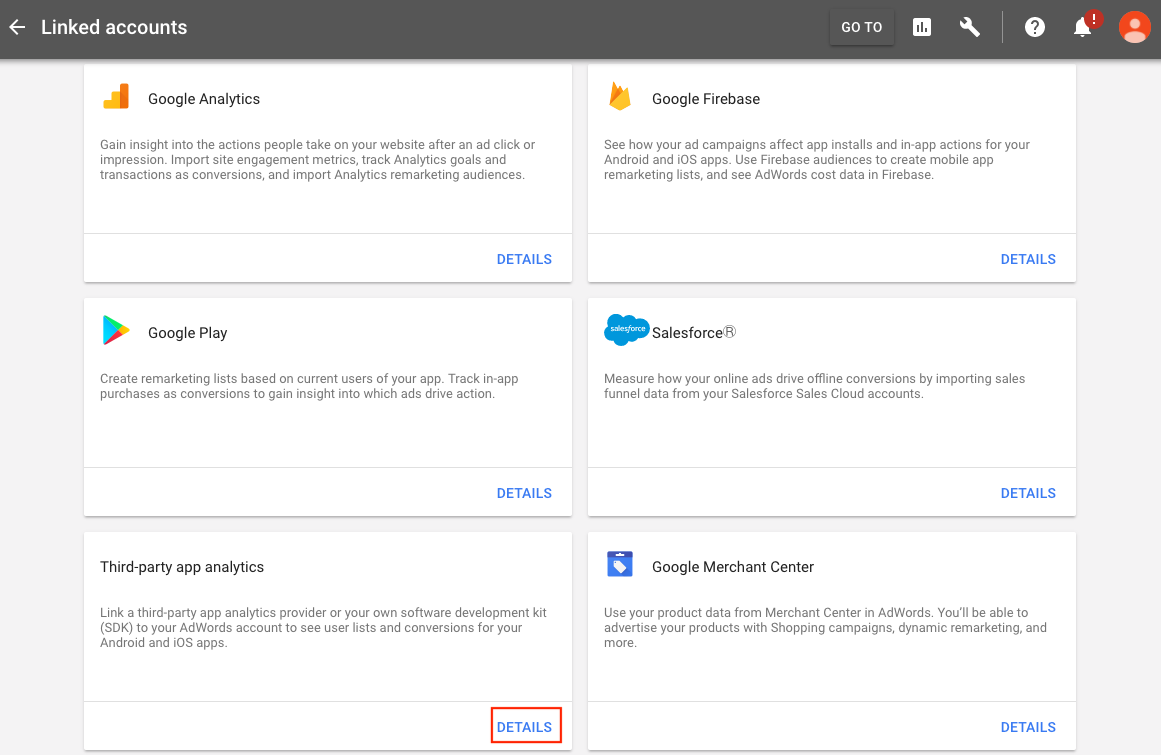
- Navigate to App analytics provider > Other provider, and enter mParticle’s provider ID:
4353943319
- Select your app’s platform and find your app in the Look up your app field.

- Click the CREATE LINK ID button. The screen refreshes to show you the Third-party app analytics page with the LINK IDs you’ve just created.

Using the Link ID in the mParticle App
You will use this Link ID in the mParticle app when you create a output connection in the Connection Output dialog.
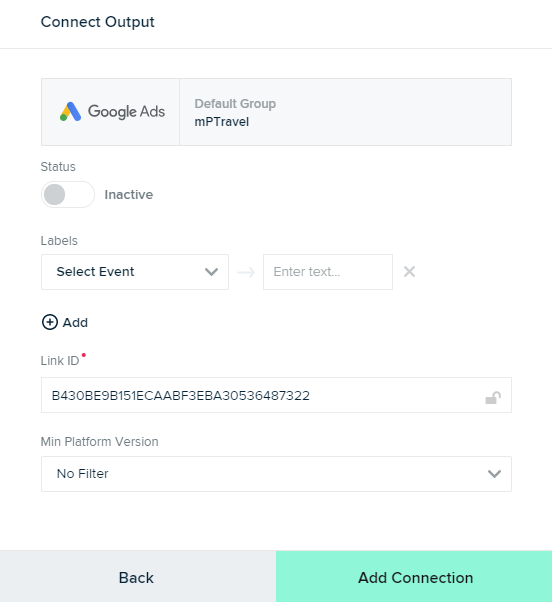
Data Mapping (Native Apps and Web)
Google’s current conversion tracking API supports a standard list of event types. mParticle events are automatically mapped to the appropriate Google Ads events as follows. The following table shows the data mapping for both native apps and Web.
Supported Events
| Google Ads Event | mParticle Event |
|---|---|
first_open |
Application State Transition, where install is true and upgrade is false. |
session_start |
Session Start |
view_item |
Commerce Event with a Product Action type of view_detail |
add_to_cart |
Commerce Event with a Product Action type of add_to_cart |
ecommerce_purchase |
Commerce Event with a Product Action type of purchase |
custom |
App Event |
Unsupported Events
| Google Ads Event | Notes |
|---|---|
in_app_purchase |
This event should be used only for purchase made in Google Play. For other purchases, use the ecommerce_purchase event. |
view_item_list |
|
view_search_results |
Commerce Event Expansion
When forwarding Commerce Events, mParticle forwards the main event - ecommerce_purchase, add_to_cart, or view_item - including the event attributes and transaction ID, plus one custom event for each Product, including the event attributes, product attributes and the Transaction ID.
Attribute Mapping
| Google Ads Attribute | mParticle Attribute |
|---|---|
app_event_name |
event_name (for App Event only) |
rdid (Raw Device ID) |
ios_advertising_id or android_advertising_id |
id_type |
"idfa" (iOS, tvOS) OR "advertisingid" (Android) |
lat |
device_info.limit_ad_tracking |
app_version |
application_info.version |
os_version |
device_info.version_release (iOS, tvOS) OR device_info.version_release (Android) |
sdk_version |
"mparticle-sdk-i-v<device_info.sdk_version>" (iOS, tvOS) OR "mparticle-sdk-a-v<device_info.sdk_version>" (Android) |
timestamp |
timestamp_unixtime_ms |
value |
product_action.total_amount (purchase only) |
currency_code |
currency_code |
Web Integration
The Google Ads integration requires the mParticle Google Ads Kit when connected to a web input. If you are initializing the web SDK using the Snippet Option then the Kit is automatically included for you. If you are Self Hosting the SDK then you need to add this kit manually into your source code.
The following settings are used for Web-specific configurations. These are the parameters you would set when setting up a Web-specific connection if you are forwarding data collected by mParticle to Google Ads.
Creating a Conversion ID and Label
You need to create a Conversion ID before you can use the Web integration for Google Ads. The instructions for creating a Conversion ID can be found at the following Google support page:
- It is recommended to click the New tab and follow the instructions on that page to generate a new Conversion ID.
- Once you have followed the steps to create a Conversion ID, you must select the Conversion IDs for the Event snippet. You will see a similar dialogue box as below.
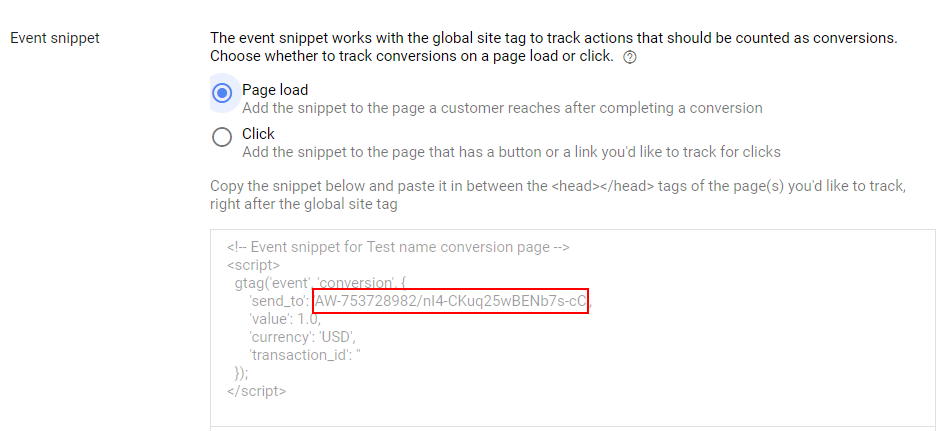
- In the
gtagfunction invocation, the last argument is an object with a key ofsend_toand a value in the format of “AW-CONVERSIONID/LABEL”. In the above example, the Conversion ID is753728982and the label isnl4-CKuq25wBENb7s-cCEnter your Conversion ID in the Event Configuration Settings when you add an event output:

- Enter your label in the Connection Settings once you connect Google Ads to Javascript as an output:

- In the mParticle app, set up the configuration (explained in the Configuration Settings section), and then configure the connection (explained in the Connection Settings section).
Using mParticle’s Events API
If you are using mParticle’s Android, iOS, or tvOS SDK, the user agent string is automatically collected for you. If you are not using these SDKs, this section explains how to construct the user agent string.
Constructing a Correctly Formed User-Agent Header
The Google Ads integration utilizes Google’s Mobile Apps Conversion Tracking and Remarketing API. This requires a correctly formatted User-Agent header, retrieved from information about the device.
If you are forwarding data collected by mParticle’s native SDKs, the required information is collected automatically. Note that the one required field is the Advertising ID in the user agent header.
If other values are not present in a batch received using the Events API, mParticle will still attempt to construct a User Agent Header, based on default values. However, mParticle cannot guarantee that this header will be accepted by Google Ads. Therefore, it is important to provide accurate values.
As explained previously, if you are not using mParticle’s Android, iOS, or tvOS SDKs (or are using the mParticle Events API), you will need to ensure the following fields are provided.
| mParticle Field | Device Type | Notes |
|---|---|---|
device_info.ios_advertising_id |
iOS, tvOS | Required. Will return an error if not present |
device_info.os_version |
iOS, tvOS | iOS version number |
device_info.android_advertising_id |
Android only | |
device_info.build_version_release |
Android only | Android version number |
device_info.locale_language |
Android, iOS, tvOS | 2-character ISO 639-1 Language Code |
device_info.locale_country |
Android, iOS, tvOS | 2-character ISO 3166-1 Country Code |
device_info.device_model |
Android, iOS, tvOS | Model of the device, e.g. iPhone6,1 |
application_info.application_version |
Android, iOS, tvOS | Version number of your app |
device_info.build_identifier |
Android, iOS, tvOS | Build number of the operating system. See the section below about Obtaining Your Build Identifier |
Obtaining Your Build Identifier
One of the required fields to be included in the user agent string is the build identifier. In order to retrieve the build identifier, you can use one of the following code snippets to retrieve it.
To obtain the device_info.build_identifier value:
String buildId = Build.ID;@import Darwin.sys.sysctl;
NSString *buildId(void) {
size_t bufferSize = 64;
NSMutableData *buffer =
[[NSMutableData alloc]
initWithLength:bufferSize];
int status =
sysctlbyname("kern.osversion",
buffer.mutableBytes,
&bufferSize, NULL, 0);
if (status != 0) {
return nil;
}
return [[NSString alloc]
initWithCString:buffer.mutableBytes
encoding:NSUTF8StringEncoding];
}Enhanced Conversions
When using the Google Ads web integration, you have the option of leveraging Google’s Enhanced Conversions. This allows you to send first-party customer data to Google in a secure way. Read more about Google’s Enhanced Conversions and how to set it up on Google’s side here.
Prerequisites
-
mParticle prequisites:
- Your web workspace needs to be configured for event batching in order to leverage Enhanced Conversions. If it is not configured for event batching, please contact your customer success manager. To determine if you are on web batching, follow the instructions here.
- Check both
Enable Google Site TagandEnable Enhanced Conversionsin connection settings.
Creating a Conversion ID and Label
As with non-enhanced conversions, you will need to create a Conversion ID. Follow those directions from above.
Additionally, there are a few extra steps to set up enhanced conversions in Google’s set up page:
- Under
Enhanced conversions, selectTurn on enhanced conversions. - Under
Implementation Method, selectGlobal site tag or Google Tag Managerand pressNEXT. - You will be prompted for your URL. Enter that into the text field and click
CHECK URL.
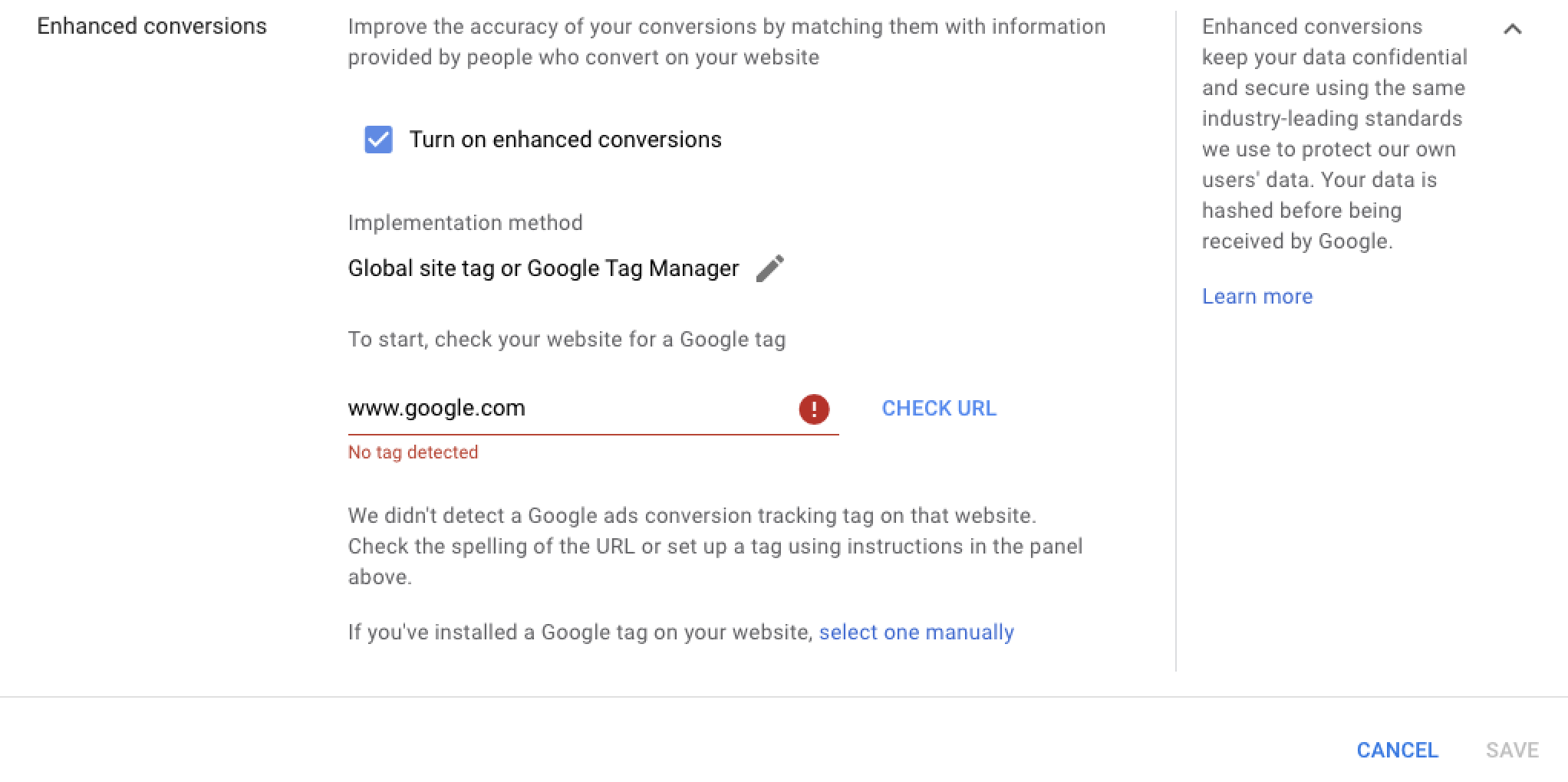
- If mParticle loads Google Tag Manager dynamically for you, Google tells you that the tracking tag was not detected. Click on
select one manually. If you don’t see this message, go to the next step. - Click the
Global site tagradio button and pressNEXT.

- Select
Edit codefrom the drop down for how you want to set up enhanced conversions.
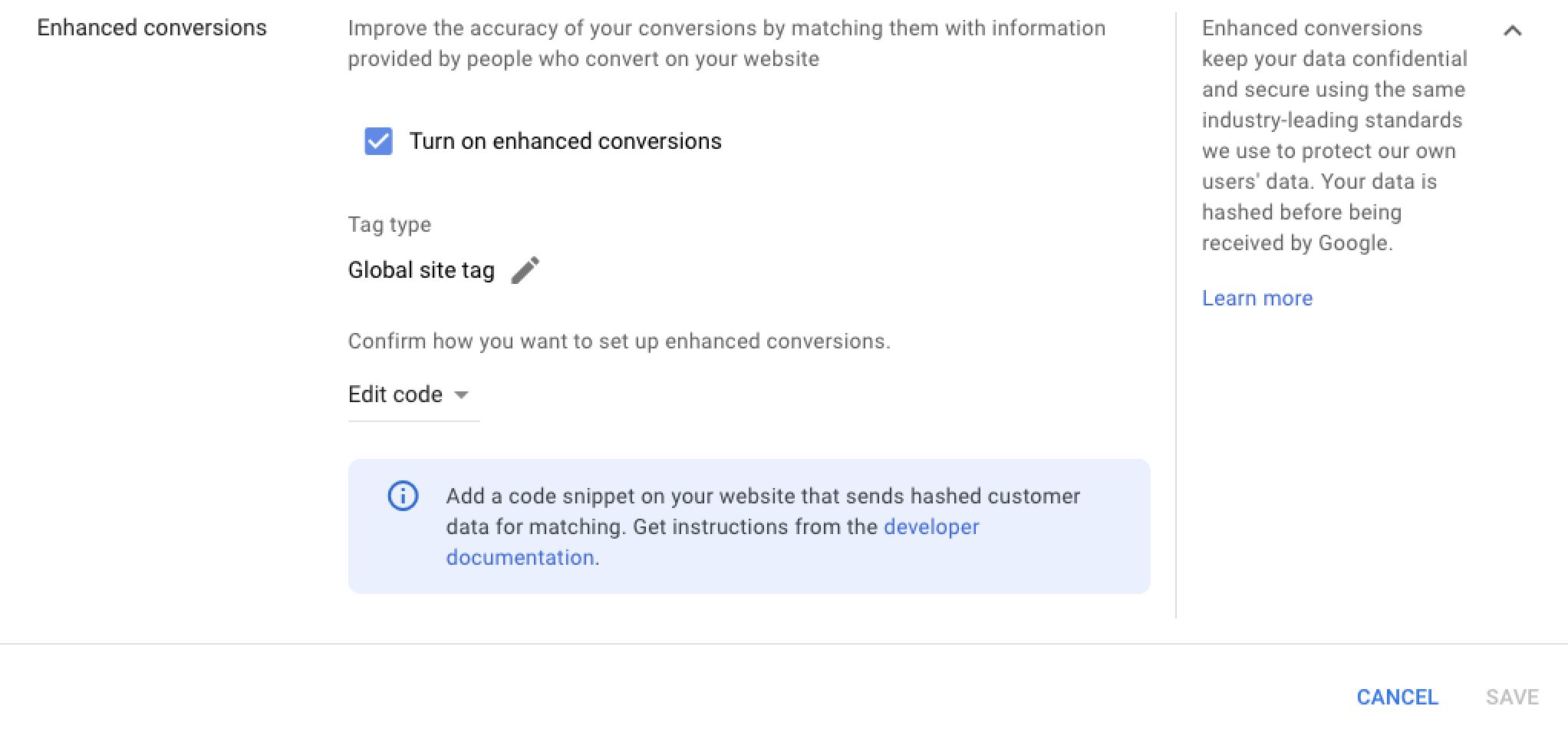
After completing the set up from Google’s side, you are ready to send Enhanced Conversions via mParticle to Google. Following the Test Search example below, simply pass unhashed first-party data, to the custom flag "GoogleAds.ECData" as a Custom Flag containing a stringified JSON Object.
The format of your first party data should follow Google’s support docs here under Identify and define your enhanced conversions variables. See below for a full example:
mParticle.logEvent(
'Test Search',
mParticle.EventType.Search,
{ attr1: 'value1' },
{ "GoogleAds.ECData": JSON.stringify({
email: 'test@gmail.com',
phone_number: '1-911-867-5309',
first_name: 'John',
last_name: 'Doe',
home_address: {
street: '123 Main St',
city: 'San Francisco',
region: 'CA',
postal_code: '12345',
country: 'US',
}});
}); Per Google’s best practices, mParticle passes a unique ID for each event to Google in the form of a transaction_id in order to de-duplicate events. If you are logging a purchase event, you are required to provide a transaction ID. Otherwise, the mParticle Web SDK automatically assigns all non-purchase commerce events, page views, and custom events a transaction_id.
Consent
Google Ads has several notions of user-provided consent. Two of these apply to the S2S Google Ads events: ad_user_data and ad_personalization. These represent consent for ad user data and ad personalization.
For Web Customers using Google Ads Consent Mode, Google provides two additional fields: ad_storage and analytics_storage.
Additionally, based on the configured connection setting, server-to-server calls for iOS, Android and tvOS will indicate whether European regulations apply.
User-specified Consent
To configure user consent forwarding under this value, a mapping should be set-up leveraging mParticle’s notion of Consent Purposes. To learn more about handling user consent within mParticle’s platform, see the following docs: Data Privacy Controls.
Once a Consent Purpose is set up, user consent information can be associated with it in subsequent Event Batches. The Consent Purpose data mapping can then be configured for downstream forwarding via the User Consent Data Mapping connection setting.
Consent Defaults
In the absence of a user-defined consent value for the ad_user_data, ad_personalization, ad_storage, and analytics_storage fields via the Consent Purpose mapping, a default value can be optionally configured via a separate drop-down setting for each consent type. When no user consent is provided, the default status is used, if specified. If omitted, the Unspecified status will be sent.
Caution: It is recommended that in the long term, you set up user-specified consent through the Consent Purpose mapping, such that the user consent is correctly forwarded to Google. It is your responsibility as a Data Controller to stay compliant under the GDPR, and set up user consent collection for downstream forwarding. The consent default setting can be deprecated in the future.
Consent Behavior (Web)
mParticle follows Google’s recommendations when forwarding consent state defaults and consent state updates. However, the Web kit behaves differently depending on how your default consent states are configured:
-
If your consent state default is set to
DeniedorGranted:- Whenever a user changes their consent state away from the default, the Web kit forwards the new value downstream the next time a
custom eventorpage viewevent is triggered. - Whenever a page is refreshed or the kit is re-initialized, the default consent states are automatically forwarded downstream, along with any consent state changes the user may have made.
- Whenever a user changes their consent state away from the default, the Web kit forwards the new value downstream the next time a
-
If your consent state default is set to
Unspecified:- As soon as a user accepts or denies the consent purposes specified in your connection settings, the mapped consent states are set as the defaults after a page is refreshed or the kit is re-initialized. These new consent state defaults are then forwarded downstream.
mParticle App Configuration/Connection Settings (Native Apps/Web)
Regardless of whether you’re configuring/sending data from a Native Apps/Web platform, the following parameters must be set in the mParticle app. The tables below will guide you through what the parameters are and the platform to which they apply.
Configuration Settings
To create a new Google Ads events output:
- Go to Data Platform > Setup > Outputs using the left navigation.
- Click Add Event Output, then search for and select “Google Ads”.
- Continue filling out the setting fields described in the table below:
| Setting Name | Data Type | Default Value | Platform | Description |
|---|---|---|---|---|
| Configuration Name | string |
All | The descriptive name you provide when creating the configuration. This is the name you will use when setting up the output connection to Google Ads. | |
| Conversion ID | string |
All | The conversion ID provided in your Google Ads conversion tracking code snippet. This is only used for the legacy version of Google Ads | |
| App Install Conversion Label | string |
Native Apps | The label provided in your Google Ads conversion tracking code snippet for app installs. This is only used for the legacy version of Google Ads |
Connection Settings
To create a connection between an input and a Google Ads event output configuration:
- Go to Data Platform > Setup > Connections.
- Select the input you want to connect to Google Ads.
- Click Connect Output and select the Google Ads events configuration you want to use.
- Continue by filling out the setting fields described in the table below:
| Setting Name | Data Type | Default Value | Platform | Description |
|---|---|---|---|---|
| Labels | Custom Field |
All | The mapping of your events to Google Ads conversion labels provided in the Google Ads conversion actions section under the ‘Set up your tracking method’ heading Note that there are a maximum of 50 Labels allowed. This is only used for the legacy version of Google Ads |
|
| Custom Parameters | Custom Field |
Web | The mapping of your event attributes to Google Ads custom parameters as setup in the tracking template field under Campaign Advanced Settings. (Max # of Mappings Allowed: 3) Note that there are a maximum of three (3) Custom Parameters allowed. |
|
| Link ID | string |
iOS, Android, tvOS | The unique identifier for binding a specific app to a specific developer token. If not present, we will use the legacy version of Google Ads | |
| Remarketing Only | bool |
False | Web | If enabled, the integration is set to remarketing only mode which allows you to improve your marketing campaign’s targeting. |
| Enable Google Site Tag | bool |
False | Web | If enabled, the Google Site Tag (gtag) JavaScript tagging framework and API is used for conversion tracking. |
| Applies European Regulations | bool |
False | iOS, Android, tvOS | If enabled, server-to-server calls will indicate that European regulations apply. |
| Consent Data Mapping | mapping |
null | All | A mapping of mParticle consents to Google Ads consents. |
| Ad User Data Default Consent Value | string |
Unspecified |
All | The default consent value to forward for the Ad User Data field. |
| Ad Personalization Default Consent Value | string |
Unspecified |
All | The default consent value to forward for the Ad Personalization field. |
| Ad Storage Default Consent Value | string |
Unspecified |
Web | The default consent value to forward for the Ad Storage Field |
| Analytics Storage Default Consent Value | string |
Unspecified |
Web | The default consent value to forward for the Analytics Storage Field |
- Last Updated: December 16, 2025